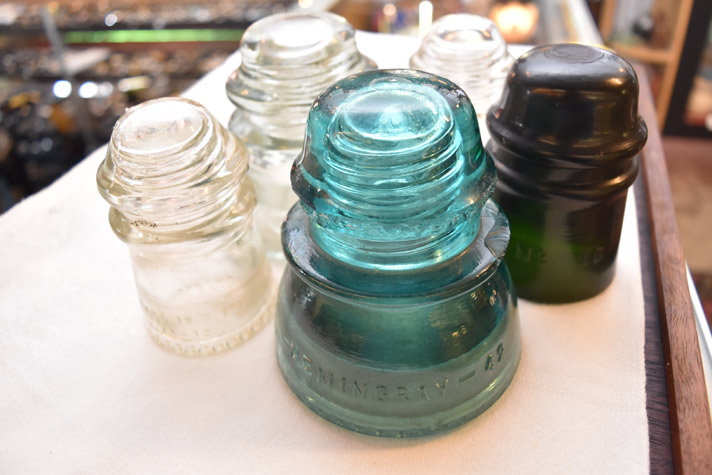Speaking of Antiquing – July 2017
Glass insulators have been around since 1840 when the first telegraph lines were strung across America. They were non-threaded, and had wings or “ram’s horns” that some collectors today call “Mickey Mouse ears.” Another type from that era was the “glass block” design. They were square-ish. Soon after that the pinhole or pin style was used, allowing it to be attached on a wood “pin.” This led to Louis Cauvet designing the threaded style, making them more secure on pins through all types of weather. This is still the standard today.
Millions of glass insulators were produced each year, in varying shapes, between 1920 and 1940 to keep up with the demand for electrification of our country. One of the most prolific manufactures of insulators was the Hemingray Glass Co. They produced many jars, bottles, and glassware in Kentucky and Indiana, taking pride in their insulator production. They used top quality glass in various colors, as opposed to some glass manufacturing companies using slag glass. They embossed the insulators with their name, patent numbers, and a coding system that makes it possible for collectors today to identify the production location, age and type. These reference pages are available online and I was amazed at how many different types of insulators there were, many I had never seen.
Aqua glass insulators were the first things that I collected back in rural South Dakota in the early 1970’s. They were plentiful, and so common that we would make candlesticks out of them and throw them away when they were completely covered in wax. We would find tops of old telegraph and telephone poles on our hikes through the Black Hills, and we would use them for target practice. It’s a good thing I held on to a few of them!
Many collectors find the clear and aqua skirted insulators generic and less desirable. Rare is amber, cobalt blue, olive green, and royal purple. Not only are some colors rare, but certain styles of insulator are almost impossible to find, in any color. You will have to consult the Hemingray identifications pages to identify yours, and learn the names of the designs, such as Pony, Keg, Rumple, Three Rumple, Seilers, Bullet, Big Mouth, Hockey Puck, Teepee, Hoopskirt, to name a few.
There is always something more to learn about something we may think of as a common item.
Be aware that insulators have been reproduced by using molds of originals. Be sure to check style numbers, glass thickness and quality, and color. Also check the crown shape and the bottom drip points; if the points are smooth, it could be a reproduction.
Salesman samples were made in the 1920s-1930s, and were made in three colors: Aqua, Green, and Amber. They had sharp dip points. These are being reproduced as well in colors not used by Hemingray.
We have a selection of insulators here at Pickety Place if you want to add to or begin a collection.

 Margaret Barns is co-owner of Pickety Place Antiques & Collectibles located at 130 N. 4th Street in Jacksonville. LIKE them on
Margaret Barns is co-owner of Pickety Place Antiques & Collectibles located at 130 N. 4th Street in Jacksonville. LIKE them on